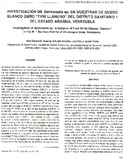Mostrar el registro sencillo del ítem
Investigación de Salmonella sp. En muestras de queso blanco duro "tipo llanero" del distrito sanitario 1 del estado Aragua, Venezuela
| dc.rights.license | http://creativecommons.org/licenses/by-nc-sa/3.0/ve/ | |
| dc.contributor.author | Scaramelli, Aura | |
| dc.contributor.author | Citti, Rosanna | |
| dc.contributor.author | González, Ilde | |
| dc.contributor.author | Páez, Lucy | |
| dc.contributor.author | Tromp, Jannet | |
| dc.date.accessioned | 2009-03-13T16:06:00Z | |
| dc.date.available | 2009-03-13T16:06:00Z | |
| dc.date.issued | 2009-03-13T16:06:00Z | |
| dc.identifier.issn | 0798-2259 | |
| dc.identifier.uri | http://www.saber.ula.ve/handle/123456789/27159 | |
| dc.description.abstract | Se evaluó la potencialidad del queso blanco duro criollo tipo "llanero" como vehículo de transmisión de Salmonella sp., sobre 100 muestras de quesos adquiridos en diferentes expendios del Distrito Sanitario 1 del Edo. Aragua, Venezuela. Para la investigación de Salmonella sp., se empleó la metodología establecida en la Norma COVENIN N° 1291-88, con algunas modificaciones. Por otra parte, en todas las muestras se realizó Recuento Total de Aerobios Mesófilos (RTAM), Número Más Probable de Coliformes Totales (NMPCT) y Fecales (NMPCF) y Análisis físico químico que incluyó: pH, actividad de agua (aw), acidez, cloruros y humedad. Las medias de los logaritmos del RTAM, NMPCT y NMPCF fueron 7,01 ± 0,78; 2,70 ± 1,64 y 2,41 ± 1,56, respectivamente. El 96% de las muestras presentaron RTAM superiores a 106 UFC/g. En sólo un 29 y 32% de ellas, el NMPCT y NMPCF fue inferior a 10 coliformes/g. En el 68 y en el 62% de las muestras el NMPCT y el NMPCF, respectivamente, fueron superiores a 100 coliformes/g. Los análisis físico-químicos arrojaron las siguientes valores medios: pH = 5,09 t 041, acidez = 0,51 ± 0,28; aw = 0,91 ± 0,03; Humedad = 56,02 ± 3,66 y Cloruros (% NaCI) = 4,37 ± 1,15. En el 2% de las muestras se confirmó la presencia de Salmonella sp. Uno de los aislados aglutinó con suero polivalente C (DifcoTM-PolyC 2536-47) que incluye los grupos I, J, K, M, N y O y el otro, fue confirmado como perteneciente al Grupo D, al aglutinar con los anti-sueros polivalente A (DifcoTM Poly A 2534-47) y monovalente para el factor antigénico 0:9. La tipificación de esta cepa no pudo efectuarse. El aislamiento de Salmonella sp. En el 2% de los quesos, siendo una de las cepas del grupo D, refuerza la necesidad de desarrollar políticas dirigidas a mejorar la calidad sanitaria del producto. | es_VE |
| dc.rights | info:eu-repo/semantics/openAccess | |
| dc.subject | Salmonellas sp. | es_VE |
| dc.subject | Bacteriología de quesos | es_VE |
| dc.subject | Salmonela en queso blanco duro tipo "llanero" | es_VE |
| dc.title | Investigación de Salmonella sp. En muestras de queso blanco duro "tipo llanero" del distrito sanitario 1 del estado Aragua, Venezuela | es_VE |
| dc.title.alternative | Investigation of Salmonella sp. In samples of hard white cheese "llanero" in the N° 1 sanitary district of the Aragua State, Venezuela | es_VE |
| dc.type | info:eu-repo/semantics/article | |
| dc.description.abstract1 | The potentiality of hard white cheese of the "plains" variety as a vehicle for the transmission of Salmonella sp. was evaluated in 100 samples of cheese acquired in different sales of the N° 1 Sanitary District of Aragua State. Salmonella sp., was detected according to a modified the COVENIN Norm N° 1291-88 was used, with certain modifications. In addition, the total mesophilic aerobe count (RTAM), the most probable number of coliform, total (NMPCT) and fecal (NMPCF), were performed, together with a physico-chemical analysis which included pH, water activity (aw), acidity, chlorides and humidity. The mean of the logarithms of the RTAM, NMPCT and NMPCF were 7.01 ± 0.78; 2.70 ± 1.64 y 2.41 ± 1.56, respectively. 96% of the samples showed RTAM higher than 106 UFC/g. In the 29 and 32% of them NMPCT and NMPCF were less than 10 coliform/g. In 68 and 62% of the samples NMPCT and NMPCF respectively, were superior to 100 coliform/g. The physico-chemical analysis showed the following mean values: pH = 5.09 ± 041, acidity = 0.51 ± 0.28; aw = 0.91 ± 0.03; Humidity = 56.02 ± 3.66 y Chlorides (% NaCI) = 4.37 ± 1.15. In 2% of the samples, the presence of Salmonella sp. was confirmed. One of the isolated agglutinated with polyvalent C serum (DifcoTM-PolyC 2536-47) which includes the groups I, J, K, M, N y O and the other isolated was confirmed as Salmonella sp. of group D, on agglutinating with polyvalent antiserum A (DifcoTM Poly A 2534-47) and monovalent antiserum for the 0: 9 antigenic factor. These strains could not be typed. The isolation of Salmonella sp. from 2% of cheeses, one of the strains been of group D, reinforced the need to develop policies to improve the quality of the product, especially in relation to the sanitary aspects. | es_VE |
| dc.description.colacion | 167 - 173 | es_VE |
| dc.description.frecuencia | Bimestral | |
| dc.identifier.depositolegal | 199102ZU46 | |
| dc.subject.institucion | Universidad del Zulia (LUZ) | es_VE |
| dc.subject.institucion | Universidad de Los Andes (ULA) | es_VE |
| dc.subject.keywords | Salmonellas sp. | es_VE |
| dc.subject.keywords | Cheese bacteriology | es_VE |
| dc.subject.keywords | Salmonella in hard white cheese "llanero" variety | es_VE |
| dc.subject.publicacionelectronica | Revista Científica | |
| dc.subject.tipo | Revistas | es_VE |
| dc.type.media | Texto | es_VE |
Ficheros en el ítem
Este ítem aparece en la(s) siguiente(s) colección(ones)
-
Revista Científica - 1999 - Vol IX - No. 003
mayo - junio



